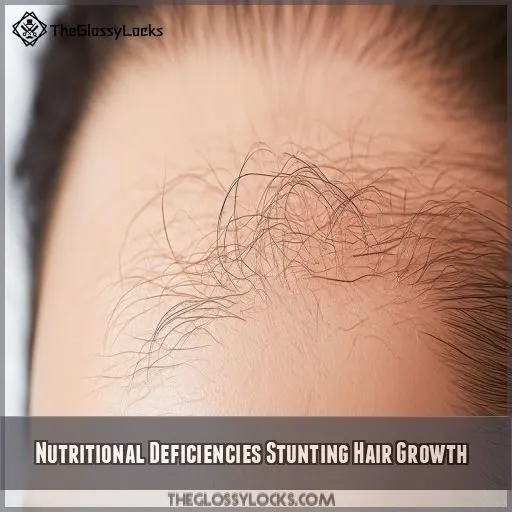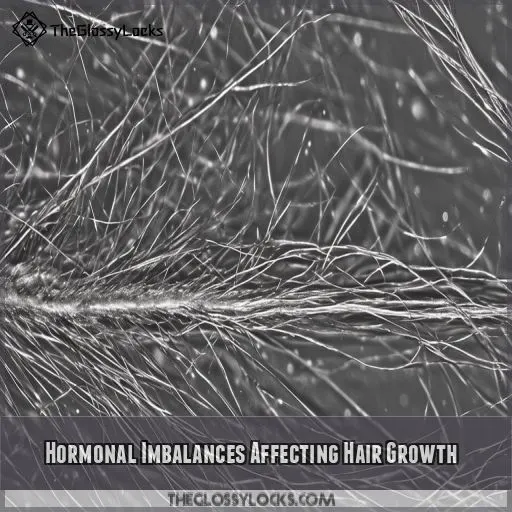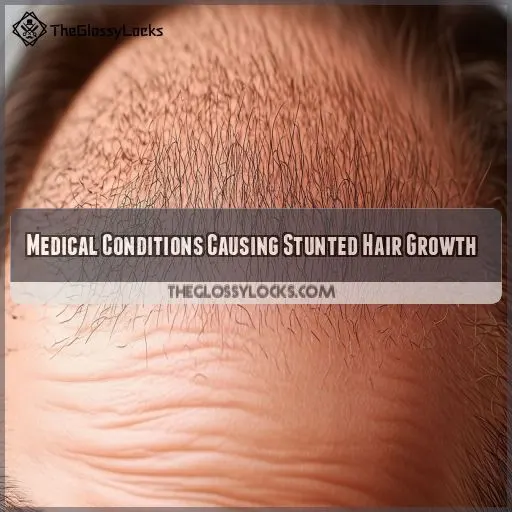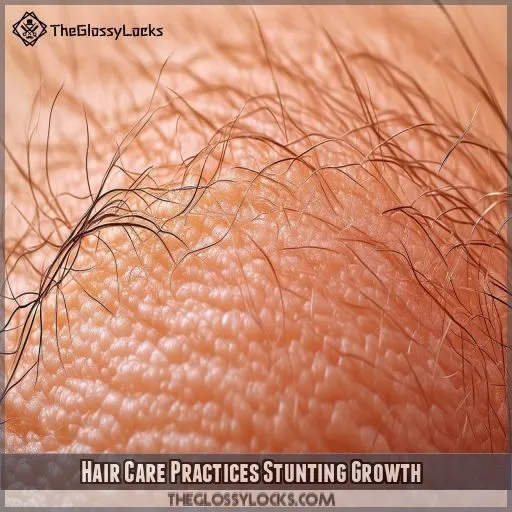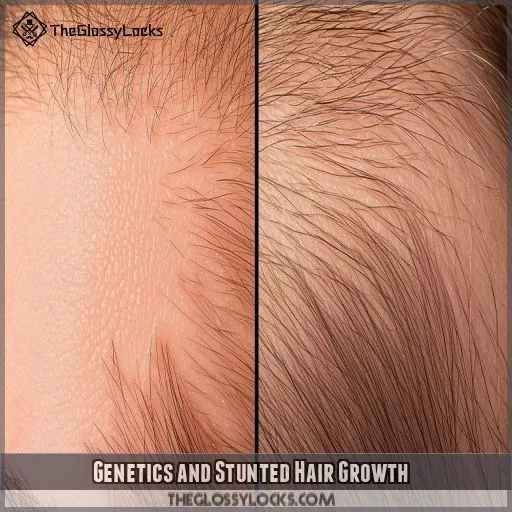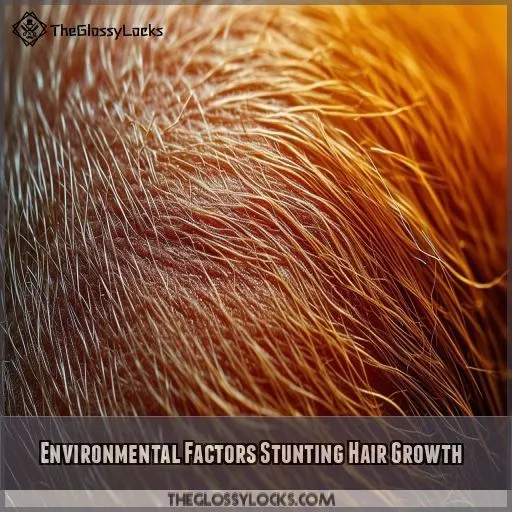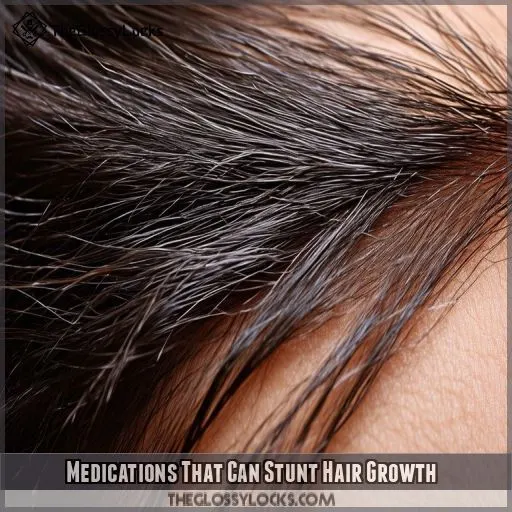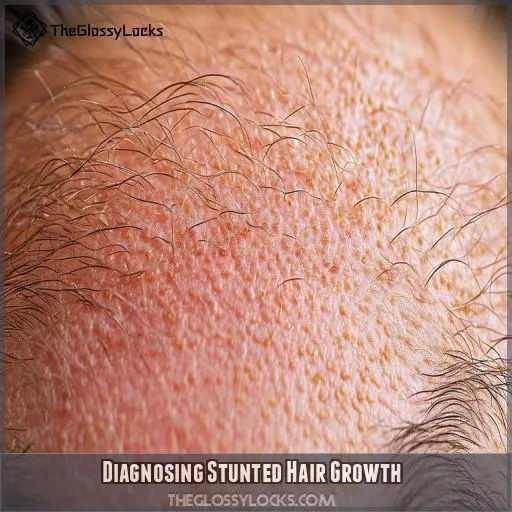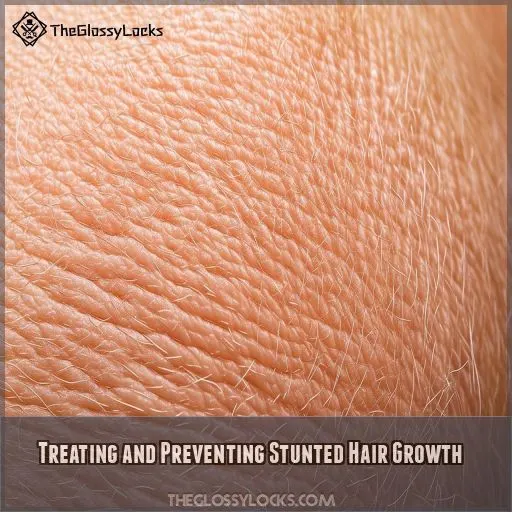This site is supported by our readers. We may earn a commission, at no cost to you, if you purchase through links.
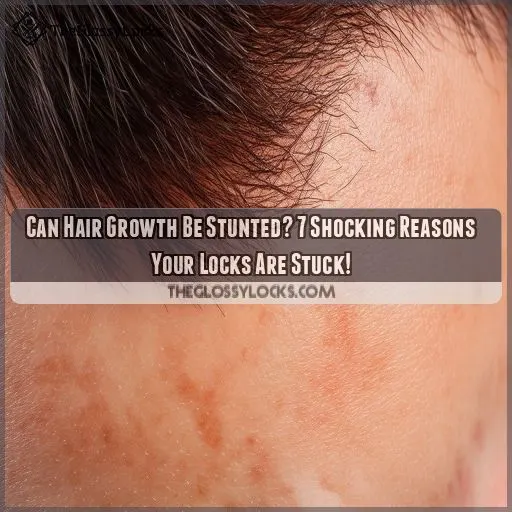 Yes, your hair growth can be stunted, and it’s not just your imagination!
Yes, your hair growth can be stunted, and it’s not just your imagination!
Think of your locks as plants in a garden – they need the right nutrients, care, and environment to thrive.
Factors like poor nutrition, hormonal imbalances, and even your trusty hair straightener can put the brakes on growth.
Stress, medical conditions, and genetics also play a role in this follicular fiasco.
But don’t worry, you’re not doomed to a life of lackluster locks!
With the right approach, you can give your hair the boost it needs.
Ready to uncover the shocking reasons behind your stunted strands and learn how to get that mane moving again?
Table Of Contents
- Key Takeaways
- Can Hair Growth Be Stunted?
- Nutritional Deficiencies Stunting Hair Growth
- Hormonal Imbalances Affecting Hair Growth
- Medical Conditions Causing Stunted Hair Growth
- Hair Care Practices Stunting Growth
- Genetics and Stunted Hair Growth
- Environmental Factors Stunting Hair Growth
- Medications That Can Stunt Hair Growth
- Diagnosing Stunted Hair Growth
- Treating and Preventing Stunted Hair Growth
- Frequently Asked Questions (FAQs)
- Is it possible for hair not to grow?
- Why is my hair short and not growing?
- Does growing hair stunt growth?
- Can hair stop growing at a certain length?
- Can stress or trauma stunt hair growth?
- Does sleeping position affect hair growth patterns?
- Can certain hairstyles cause permanent hair growth issues?
- How does age impact the rate of hair growth?
- Can excessive exercise or extreme dieting stunt hair growth?
- Conclusion
Key Takeaways
- Your luscious locks can hit the pause button due to a hair-raising cocktail of factors – from sneaky nutritional deficiencies to hormonal changes. Who knew your mane was such a drama queen?
- Treat your tresses like a temperamental garden – they need the right nutrients, TLC, and environment to flourish. Overdo the heat styling, and you might as well be taking a blowtorch to your flowerbeds!
- Don’t let your genes throw you for a loop – while they play a starring role in your hair’s destiny, they’re not the be-all and end-all. With the right moves, you can still be the director of your own hair-growth success story.
- From pollution playing the villain to medications stealing the spotlight, your hair’s growth story has more plot twists than a soap opera. But fear not – with a little detective work and some hair-care heroics, you can turn that tragedy into a triumphant tale of tresses!
Can Hair Growth Be Stunted?
Ever wondered why your hair seems to be stuck in a growth rut? You’re not alone – stunted hair growth is a real issue that can leave you feeling frustrated and wondering what’s holding your locks back.
Definition of Stunted Hair Growth
Ever feel like your hair’s stuck in time? Stunted hair growth is when your locks aren’t reaching their full potential. It’s like your hair’s hit the pause button, refusing to grow longer or thicker. Let’s unpack what’s really going on:
- Your hair’s playing hide-and-seek with length
- Thinning tresses that won’t bounce back
- Growth rate slower than a snail’s pace
- Locks that seem to have hit an invisible ceiling
- hair cycle stuck on repeat, skipping the growth phase
Common Misconceptions About Hair Growth
You’ve heard the myths: "Cutting hair makes it grow faster!" or "Brushing 100 strokes daily boosts growth!" Let’s bust these hair growth fairytales. While you can’t magically speed up growth, understanding what really affects your locks is key to healthier, happier hair.
Normal Hair Growth Cycle
Now that we’ve debunked those hair myths, let’s get into the nitty-gritty of your locks’ life cycle. Your hair goes through three stages: growing (anagen), changing (catagen), and resting (telogen). It’s like a never-ending hair party on your scalp!
Signs of Stunted Hair Growth
Ever feel like your locks are stuck in a hair-raising time warp? You’re not alone! Stunted growth can be a real head-scratcher. From snail-paced length gains to thinning patches, your mane might be waving red flags. Let’s uncover the signs your tresses are crying for help!
Nutritional Deficiencies Stunting Hair Growth
You might be surprised to learn that what’s on your plate could be holding back your hair growth. Nutritional deficiencies can throw a wrench in your hair’s growth cycle, leaving you wondering why your locks seem stuck in a rut.
Essential Vitamins for Hair Health
Your locks crave vitamins like your car craves fuel! Biotin, the hair hero, partners with vitamins A, C, and E to keep your mane mighty. Don’t forget iron and zinc – they’re the unsung heroes of scalp health. Nourish from within for luscious locks!
Protein Deficiency and Hair Growth
Your hair’s craving protein like a plant needs water! Without it, your locks can’t grow their best. Think of protein as the building blocks for luscious hair. If you’re not getting enough, your mane might throw a fit, leaving you with lackluster, stunted growth.
Iron Deficiency and Hair Loss
Just like protein, iron’s important for your luscious locks. If you’re feeling wiped out and your hair’s thinning, iron deficiency might be the culprit. Here’s why it matters:
- Iron fuels hair follicle growth
- Anemia can trigger excessive shedding
- Low iron = less oxygen for your scalp
- Fatigue often accompanies hair loss
Zinc and Biotin for Hair Growth
While iron’s super important, don’t forget about zinc and biotin! These powerhouse nutrients are like your hair’s secret weapons. Zinc keeps your follicles firing on all cylinders, while biotin’s the building block for luscious locks. A deficiency could leave your mane feeling stuck in neutral.
Hormonal Imbalances Affecting Hair Growth
You might be surprised to learn that your hormones play a huge role in your hair’s growth and health. From thyroid issues to testosterone levels, hormonal imbalances can wreak havoc on your locks, leaving you scratching your head (quite literally) about why your hair just won’t grow.
Thyroid Disorders and Hair Growth
While nutrients are important, your thyroid’s health can be a game-changer for your locks. This butterfly-shaped gland orchestrates your body’s hormones, and when it’s out of whack, your hair might decide to take an unexpected vacation. Here’s why:
- Hypothyroidism: Slows metabolism, leading to brittle, thinning hair
- Hyperthyroidism: Speeds up metabolism, causing hair to fall out faster
- Autoimmune thyroid disorders: Can trigger sudden, patchy hair loss
- Thyroid medication imbalances: May cause temporary hair shedding
Androgens and Male Pattern Baldness
Moving from thyroid troubles to another hormonal hair-wrecker: androgens and male pattern baldness. You’ve heard of DHT, right? It’s the buzz-kill of hair follicles, shrinking them faster than your favorite shirt in a hot wash. Check out this hair-raising comparison:
| DHT’s Impact | Your Hair’s Reaction |
|---|---|
| Follicle Shrinkage | Thinning Strands |
| Shortened Growth Phase | Slower Growth |
| Increased Shedding | Visible Scalp |
| Delayed Regrowth | Receding Hairline |
| Scalp Sensitivity | Itchy, Inflamed Skin |
Estrogen Fluctuations and Hair Thinning
While men battle DHT, ladies, you’ve got your own hormonal hair-raiser: estrogen fluctuations. During menopause, your estrogen levels take a nosedive, and your luscious locks might follow suit. It’s like your hair’s throwing a tantrum, thinning out and leaving you scratching your head.
PCOS and Hair Growth Issues
Ever wondered if your hormones are playing tricks on your tresses? PCOS might be the culprit! This hormonal rollercoaster can lead to hair loss, leaving you feeling like you’re shedding more than your cat. Don’t worry, though – with the right treatment and support, you can regain control.
Medical Conditions Causing Stunted Hair Growth
You might be surprised to learn that certain medical conditions can put the brakes on your hair growth. From autoimmune disorders to pesky scalp infections, these health issues can leave your locks feeling lackluster and struggling to reach their full potential.
Alopecia Areata and Hair Loss
Ever noticed mysterious bald spots popping up? You might be dealing with alopecia areata, a sneaky autoimmune condition that plays hide-and-seek with your hair. It’s like your immune system decides to crash the hair growth party, leaving you with patchy hair loss. Don’t panic! While it can be unpredictable, many people see regrowth over time.
Scalp Infections and Hair Growth
While alopecia areata can be tricky, don’t let scalp infections fly under your radar! These sneaky culprits can put the brakes on your hair growth journey. From fungal fiends to bacterial bad guys, your scalp’s health is vital. Remember, a happy scalp equals happy hair. So, let’s tackle those infections head-on and get your locks flowing again!
Autoimmune Diseases Affecting Hair
Just when you thought scalp infections were bad, autoimmune diseases can throw your hair growth for a loop too! Your body might mistake your hair follicles for invaders, causing patchy hair loss. Conditions like alopecia areata or lupus can leave you scratching your head—literally! But don’t worry, there are management strategies to help you regain control.
Hair Care Practices Stunting Growth
You might be sabotaging your hair growth without even realizing it! From scorching heat tools to tight ponytails, your daily hair care routine could be stunting your locks’ potential to reach new lengths.
Over-Styling and Heat Damage
While medical conditions can stunt hair growth, your styling habits might be the real culprit! That sleek look you’re after could be costing you precious inches. Let’s take a look at how your hot tools and styling routine might be secretly sabotaging your hair goals.
Chemical Treatments and Hair Breakage
Ever feel like your hair’s throwing a tantrum after a chemical treatment? You’re not alone! Those harsh salon processes can leave your locks feeling more brittle than grandma’s cookies. But don’t worry, we’ll unravel the mystery of chemical damage and show you how to keep your mane magnificent.
Tight Hairstyles and Traction Alopecia
Tight hairstyles aren’t just a style choice—they’re a potential hair health hazard! Your ponytail might be giving you a face-lift, but it’s also tugging at your roots. This constant tension can lead to traction alopecia, a fancy term for stress-induced hair loss.
Improper Washing and Drying Techniques
While tight styles can lead to hair loss, your washing routine might be the real culprit. Are you over-shampooing or using harsh products? Your hair’s crying out for gentler care! Let’s take a closer look at how improper washing and drying techniques could be stunting your luscious locks.
Genetics and Stunted Hair Growth
You might be surprised to learn that your genes play a significant role in determining your hair growth potential. From hereditary baldness patterns to the length of your hair growth cycle, your DNA holds the key to understanding why your locks might be stuck in a growth rut.
Hereditary Hair Loss Patterns
While hairstyles can impact growth, your genes play a huge role too. Ever notice how baldness runs in families? It’s not just bad luck – hereditary hair loss patterns are like a genetic lottery. Your family tree might hold clues to your hair’s future!
Genetic Factors in Hair Thickness
Your hair’s thickness isn’t just about luck—it’s in your genes! Think your locks are thin as a whisper? Blame your DNA. Here’s what you need to know:
- Genetics determine hair follicle size
- Larger follicles = thicker strands
- Hair density varies by ethnicity
- Some genes influence hair texture
DNA and Hair Growth Cycle Length
Your DNA doesn’t just dictate thickness; it’s the puppet master of your hair growth cycle too! Some lucky folks hit the genetic jackpot with lengthy growth phases, while others are stuck in the slow lane. It’s like your hair’s personal time clock!
Ethnic Differences in Hair Growth
Your DNA isn’t the only factor in hair growth; ethnicity plays a role too! Different ethnic groups have unique:
- Hair texture and growth rates
- Curl patterns and hair density
- Scalp health characteristics
Understanding these differences can help you tailor your hair care routine for the best possible growth.
Environmental Factors Stunting Hair Growth
You might be surprised to learn that your environment plays a big role in your hair’s growth and health. From pollution to hard water, the world around you can throw some serious roadblocks in the way of your luscious locks.
Pollution and Hair Health
Ever notice your hair’s looking a bit lackluster lately? Pollution might be the culprit! That smoggy air isn’t just bad for your lungs; it’s wreaking havoc on your locks. Tiny particles in the air can cling to your hair, making it dull, brittle, and prone to breakage.
UV Radiation and Hair Damage
Ever wondered why your hair’s growth seems to have hit a sunny roadblock? UV radiation might be the culprit! Just like your skin, your locks need protection from those sneaky sun rays. They can damage your hair’s structure, leaving it brittle and stunting its growth.
Hard Water Effects on Hair
Ever feel like your hair’s hitting a growth roadblock? Hard water might be the culprit! This sneaky saboteur can leave your locks feeling like straw and your scalp itchier than a wool sweater. But don’t worry, we’ll get into how to combat this mineral menace!
Climate Impact on Hair Growth
Ever noticed your hair behaving differently with the seasons? Climate plays a huge role in your locks’ growth journey. Here’s how Mother Nature affects your mane:
- Humidity: Frizz-fest central!
- Dry air: Hello, brittle strands
- Extreme temperatures: Growth slowdown city
Medications That Can Stunt Hair Growth
You might be surprised to learn that some medications can put the brakes on your hair growth. From chemotherapy drugs to common acne treatments, certain meds can impact your locks in ways you never expected.
Chemotherapy and Hair Loss
While environmental factors can wreak havoc on your locks, chemotherapy takes hair loss to a whole new level. It’s like a tornado ripping through your scalp, leaving baldness in its wake. But don’t despair! There are ways to navigate this challenging side effect.
Antidepressants and Hair Thinning
Ever noticed your hair thinning while battling the blues? Antidepressants might be the culprit! These mood-boosting meds can sometimes rain on your hair parade, causing temporary shedding. Don’t panic, though – your luscious locks aren’t gone forever. Let’s explore this hairy situation together!
Blood Pressure Medications and Hair
You might be shocked to learn that your blood pressure meds could be putting the brakes on your hair growth! Certain medications, like beta-blockers, can slow down hair production as an unwanted side effect. Don’t panic, though—there are treatment options to keep your locks flowing!
Acne Treatments Affecting Hair Growth
While you’re zapping those zits, your hair might be paying the price. Certain acne treatments, like isotretinoin, can dry out your scalp and hair follicles, potentially slowing down growth. It’s like your hair’s going on a growth strike while your skin’s getting all the attention!
Diagnosing Stunted Hair Growth
Wondering why your hair seems stuck in a growth rut? Let’s explore the various methods experts use to diagnose stunted hair growth, from analyzing individual strands to checking your blood for hidden clues.
Hair Analysis Techniques
- Nutrient deficiencies hiding in your strands
- Sneaky toxins lurking in your lovely mane
- Hormonal imbalances playing havoc
- Telltale signs of stress or illness
Scalp Examination Methods
After analyzing your hair, it’s time to get up close and personal with your scalp. Your dermatologist will examine your scalp’s health, looking for signs of inflammation, redness, or flaking. They’ll also assess your hair density and texture, giving you a clearer picture of what’s going on up there.
Blood Tests for Nutrient Deficiencies
After examining your scalp, your doctor might suggest blood tests to check for nutrient deficiencies. These tests can reveal:
- Iron levels lower than a penny’s worth
- Vitamin D as scarce as sunlight in winter
- Zinc levels zapped to zero
- Protein levels plummeting like a bad hair day
Hormonal Imbalance Testing
Wondering if your hormones are messing with your mane? Hormonal imbalance testing might be your golden ticket! Let’s get into the nitty-gritty of hormonal detective work:
| Test Type | What It Reveals |
|---|---|
| Thyroid Panel | Thyroid hormone levels |
| Testosterone | DHT levels (hair loss culprit) |
| Estrogen | Hormonal balance in women |
| Cortisol | Stress hormone impact |
| DHEA | Adrenal health indicator |
Treating and Preventing Stunted Hair Growth
If you’ve been struggling with stunted hair growth, don’t worry – there’s hope! From topical treatments to lifestyle changes, we’ll explore effective ways to revive your locks and get them growing again.
Topical Treatments for Hair Growth
Feeling like your hair’s on strike? Don’t throw in the towel just yet! Topical treatments can be your mane’s best friend. From minoxidil to caffeine-infused serums, these hair heroes work their magic right at the roots. Let’s check out your rescue options!
Oral Supplements for Hair Health
Beyond topical treatments, oral supplements can give your hair a boost from the inside out. But before you raid the vitamin aisle, let’s dish on some popular options:
- Biotin: The beauty industry’s darling
- Iron: A game-changer for many
- Vitamin D: Sunshine in a pill
- Collagen: The structural superhero
Lifestyle Changes to Promote Growth
While supplements can help, your lifestyle plays a huge role in hair health. Let’s take a closer look at some game-changing habits that’ll have your locks growing like weeds:
| Habit | Benefits |
|---|---|
| Stress-busting | Reduces cortisol, promotes growth |
| Balanced diet | Provides essential nutrients |
| Quality sleep | Boosts cell regeneration |
| Regular exercise | Improves blood circulation |
Medical Interventions for Hair Loss
When your locks refuse to grow, it’s time to call in the big guns! Medical interventions like Minoxidil and Finasteride can be game-changers. These hair-raising treatments work wonders, stimulating those sleepy follicles and putting the brakes on hair loss. Ready to reclaim your mane?
Frequently Asked Questions (FAQs)
Is it possible for hair not to grow?
Did you know that 90% of your hair is growing at any given time? Yes, it’s possible for hair not to grow. You might experience stunted growth due to genetics, nutrient deficiencies, or health conditions. Don’t worry, there’s usually a solution!
Why is my hair short and not growing?
Your hair might be short and not growing due to various factors. You’re likely dealing with nutritional deficiencies, hormonal imbalances, or styling damage. Don’t worry! With proper care and attention, you can revitalize your locks and boost growth.
Does growing hair stunt growth?
No, growing hair doesn’t stunt growth. Your hair’s always growing, but factors like nutrition, stress, and health can slow it down. If you’re worried, try scalp massages and a balanced diet to boost your mane’s potential.
Can hair stop growing at a certain length?
Ever noticed your hair seems to hit a growth ceiling? You’re not imagining things! Hair can indeed stop growing at a certain length. It’s tied to your unique growth cycle and factors like genetics, health, and care routine.
Can stress or trauma stunt hair growth?
Yes, stress and trauma can stunt your hair growth. They’ll disrupt your hair’s natural cycle, pushing more follicles into the resting phase. You might notice thinning or slower growth. Don’t worry, though—it’s often temporary!
Does sleeping position affect hair growth patterns?
Like a garden affected by its plot’s slope, your sleeping position can influence hair growth patterns. You’re not imagining things—sleeping consistently on one side might lead to more friction and pressure, potentially slowing growth in those areas.
Can certain hairstyles cause permanent hair growth issues?
Yes, certain hairstyles can cause permanent hair growth issues. You’re risking traction alopecia if you’re constantly rocking tight ponytails or braids. It’s like your hair’s crying out, "Give me a break!" Loosen up to keep your locks luscious.
How does age impact the rate of hair growth?
Ah, the irony of aging—just when you’ve mastered your hairstyle, your locks decide to slow down! As you get older, hair growth typically slows. You’ll notice longer growth cycles and thinner strands, but don’t worry—it’s a natural process.
Can excessive exercise or extreme dieting stunt hair growth?
Yes, both excessive exercise and extreme dieting can stunt your hair growth. You’re pushing your body to its limits, depriving it of essential nutrients. Your hair’s saying, "Hey, slow down! I need those vitamins too!
Conclusion
Don’t throw in the towel just yet!
While stunted hair growth can be frustrating, understanding its causes empowers you to take action.
From nutrition and hormones to styling habits and genetics, numerous factors can put the brakes on your locks.
The good news? Most causes are treatable.

